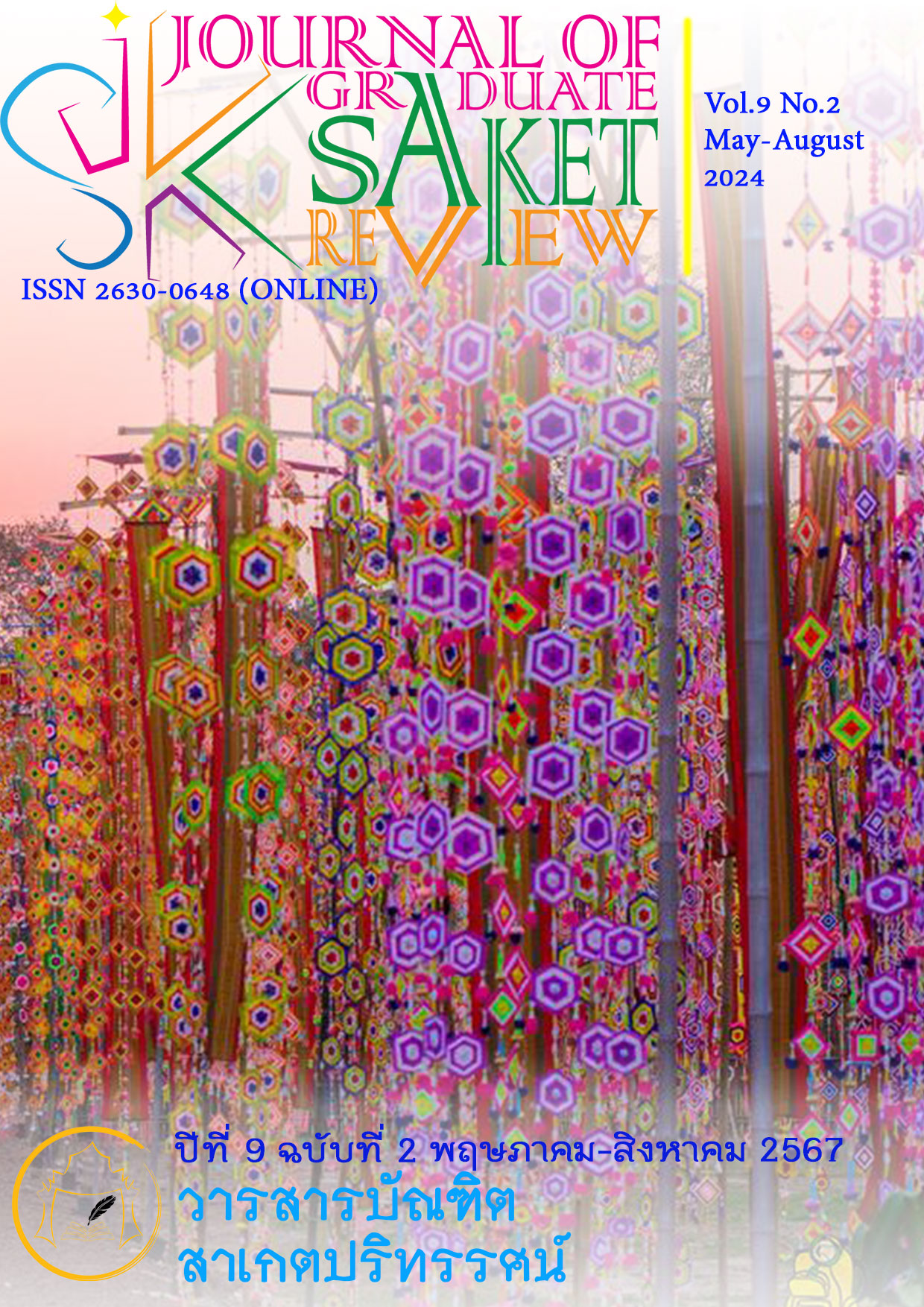กลยุทธ์การจัดการความยั่งยืนที่บูรณาการมรดกทางวัฒนธรรมของหนานหยางเข้ากับการออกแบบผลิตภัณฑ์เพื่อเศรษฐกิจเชิงสร้างสรรค์
Main Article Content
บทคัดย่อ
วัตถุประสงค์ของการศึกษาครั้งนี้คือ 1) ศึกษาและวิเคราะห์องค์ประกอบมรดกวัฒนธรรมท้องถิ่น
หนานหยาง ส่งต่อมรดกของการพัฒนาวัฒนธรรม 2) การสังเคราะห์องค์ประกอบมรดกวัฒนธรรมท้องถิ่นหนานหยางทำให้เกิดกลยุทธ์การจัดการใหม่และตัวชี้วัดสำหรับวัฒนธรรมสร้างสรรค์ร่วมสมัย การออกแบบผลิตภัณฑ์3) สร้างรูปแบบกลยุทธ์การจัดการโดยการบูรณาการมรดกทางวัฒนธรรมหนานหยางเข้ากับการออกแบบผลิตภัณฑ์ร่วมสมัย
การศึกษานี้เป็นการศึกษาแบบผสมผสาน เนื้อหาของการศึกษาเป็นกุญแจสำคัญในองค์ประกอบของมรดกวัฒนธรรมหนานหยาง ขอบเขตของการศึกษา วัตถุประสงค์การวิจัย การวิเคราะห์ทางศิลปะ กลยุทธ์
การจัดการ และกลไกการจัดการ ขนาดกลุ่มตัวอย่างคือประมาณ 172 คน ผู้ให้ข้อมูลหลักคือ ผู้เชี่ยวชาญที่เกี่ยวข้องสามประเภท (ผู้เชี่ยวชาญด้านการออกแบบ ผู้เชี่ยวชาญด้านการคุ้มครองงานศิลปะ ผู้เชี่ยวชาญด้านการจัดการเชิงกลยุทธ์); นักท่องเที่ยวที่ได้จากวิธีการสุ่มตัวอย่าง เครื่องมือที่ใช้ในการเก็บรวบรวมข้อมูล ได้แก่ เครือข่ายคอมพิวเตอร์ กล้องถ่ายรูป โทรศัพท์มือถือ เครื่องบันทึกเทป เป็นต้น ข้อมูลทางสถิติที่ใช้ในการวิเคราะห์ข้อมูลเป็นการวิเคราะห์เชิงคุณภาพและเชิงปริมาณ
ผลการวิจัยแสดงให้เห็นว่า จากการวิจัยเกี่ยวกับกลยุทธ์การจัดการที่ยั่งยืนของการบูรณาการมรดกทางวัฒนธรรมหนานหยางเข้ากับการออกแบบผลิตภัณฑ์เศรษฐกิจสร้างสรรค์ สรุปได้ว่า 1) ความจำเป็นของการพัฒนาและการจัดการที่ยั่งยืนของมรดกทางวัฒนธรรมหนานหยางและผลิตภัณฑ์เศรษฐกิจสร้างสรรค์ การออกแบบ 2) รับทฤษฎีการวิเคราะห์ทางศิลปะขององค์ประกอบมรดกทางวัฒนธรรมหนานหยางและการออก
แบบผลิตภัณฑ์ทางเศรษฐกิจเชิงสร้างสรรค์ และสร้างระบบดัชนีการประเมินผล 3) ด้วยการวิเคราะห์ผลลัพธ์ของขั้นตอนที่ 1 และวัตถุประสงค์ที่ 2 มีความเป็นไปได้ที่จะสร้างการจัดการทางศิลปะ รูปแบบและกลไกการจัดการของ "การจัดการและการพัฒนาอย่างยั่งยืนของมรดกทางวัฒนธรรมหนานหยางและการออกแบบผลิตภัณฑ์ทางเศรษฐกิจเชิงสร้างสรรค์"
Article Details

อนุญาตภายใต้เงื่อนไข Creative Commons Attribution-NonCommercial-NoDerivatives 4.0 International License.
เนื้อหาและข้อมูลในบทความที่ลงตีพิมพ์ในวารสารบัณฑิตสาเกตปริทรรศน์ ถือเป็นข้อคิดเห็นและความรับผิดชอบของผู้เขียนบทความโดยตรงซึ่งกองบรรณาธิการวารสาร ไม่จำเป็นต้องเห็นด้วย หรือร่วมรับผิดชอบใด ๆบทความ ข้อมูล เนื้อหา รูปภาพ ฯลฯ ที่ได้รับการตีพิมพ์ในวารสารบัณฑิตสาเกตปริทรรศน์ ถือเป็นลิขสิทธิ์ของวารสารบัณฑิตสาเกตปริทรรศน์ หากบุคคลหรือหน่วยงานใดต้องการนำทั้งหมดหรือส่วนหนึ่งส่วนใดไปเผยแพร่ต่อหรือเพื่อกระทำการใด ๆ จะต้องได้รับอนุญาตเป็นลายลักอักษรจากวารสารบัณฑิตสาเกตปริทรรศน์ ก่อนเท่านั้น
เอกสารอ้างอิง
Cheng Jisheng. (2022). Paths and Strategies for High-Quality Development of Henan Cultural Heritage Study Tourism[J]. Journal of Henan College of Pastoral Economics. 35(3), 31-38.
Chinese Academy of Sciences. (2003). Retrieved May 10, 2023, from https://books. google.co.th/books?hl.
China Knowledge Network, (2024). Cultural and creative products. Retrieved April 2, 2024, from https://www.chinakennisnetwerk.nl/.
Cong Xuewen. (2024). Study on the Interaction Mechanism between Rural Cultural Heritage Protection and Rural Tourism Development in Weihai City[J]. Village Director. (1), 117-119.
Keilh Dinnie. (2011). City Branding Theory and Cases. England: Macmilan Publishers Limited.
Luo Xue, Ling, Xinchen. (2023). Research on urban landscape design strategy based on cultural heritage protection[J]. Beauty and Age (City Edition). (9), 95-97.
NSTDA. (2013). GIS ?. Retrieved April 28, 2023, from https://www.nstda.or.th/ home/knowledgepost/gis/
Wikimedia. (2024). Nanyang.Hunen. Retrieved April 20, 2024, from https://en.wikipedia.org/ wiki/Nanyang Hunen.
WU Yuqing and XU Jia. (2018). Development mode of cultural and creative industries in developed countries and their cultural and creative design characteristics[J]. Hunan Packaging. 33(01), 21-23.
ZHANG Qingping, et al. (2024). Research on the development strategy system of Jiangnan
garden heritage based on sustainable concept [J]. Garden. 41(02), 12-45.
Zhang Vanadium. (2024). Literature review study on cultural creative product design in China[J]. Design. 37(01), 73-77.


